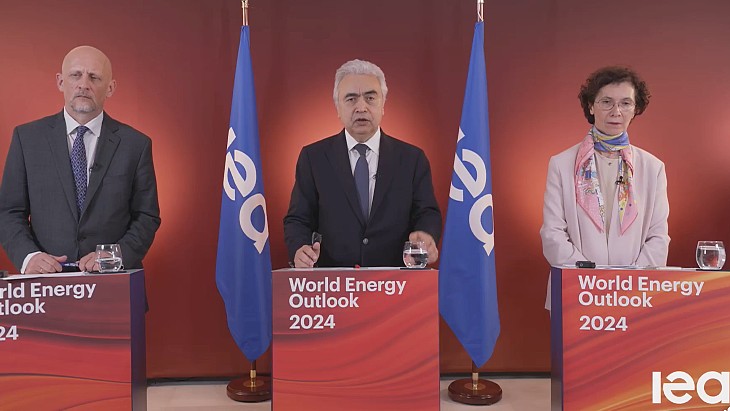"Today's geopolitical tensions and fragmentation are creating major risks both for energy security and for global action on reducing greenhouse gas emissions," according to the IEA. "The world is set to enter a new energy market context in the coming years, marked by continued geopolitical hazards but also by relatively abundant supply of multiple fuels and technologies."
IEA Executive Director Fatih Birol said: "In the second half of this decade, the prospect of more ample - or even surplus - supplies of oil and natural gas, depending on how geopolitical tensions evolve, would move us into a very different energy world from the one we have experienced in recent years during the global energy crisis."
Based on current policies, the latest report finds that low-emission sources are set to generate more than half of the world's electricity before 2030 – and demand for all three fossil fuels – coal, oil and gas – is still projected to peak by the end of the decade. However, it warns that despite growing momentum behind clean energy transitions, the world is still a long way from a trajectory aligned with its net-zero goals.
The World Energy Outlook 2024 considers three scenarios. The Stated Policies Scenario (STEPS) provides an outlook based on the latest policy settings, including energy, climate and related industrial policies. The Announced Pledges Scenario (APS) assumes all national energy and climate targets made by governments are met in full and on time. The Net Zero Emissions by 2050 Scenario (NZE) looks at what must be done to limit global warming to 1.5°C.
In the STEPS scenario, clean energy deployment accelerates as the pace of overall energy demand growth slows, leading to a peak in all three fossil fuels before 2030. Increasing reductions in coal demand means it is overtaken by natural gas in the global energy mix by 2030. Clean energy grows more than total energy demand between 2023 and 2035. Led by surging solar photovoltaic (PV) and wind power, clean energy becomes the largest source of energy in the mid-2030s.
Although the STEPS scenario sees a threefold increase in renewables that brings fossil fuel use down from 80% of total energy demand in 2023 to 58% in 2050, this falls far short of the step change that occurs in the APS scenario and the NZE scenario, especially the latter. In both these scenarios, renewables begin to rapidly eat into the fossil fuel market share. By 2035, clean energy meets 40% of global energy demand in the APS, and this rises to nearly three-quarters by 2050. In the NZE scenario, clean energy meets 90% of global energy demand in 2050. Around one-third of the remaining fossil fuel demand in the NZE scenario is fully abated, around half is used as a feedstock or in other non-energy use, and the remainder is offset by direct air capture, negative emissions from bioenergy or other forms of carbon removal.
Speaking at a press conference to launch the new report, Laura Cozzi, director of sustainability, technology and outlooks at the IEA, said: "We are expecting to see a new record high (in nuclear generating capacity) in 2025 and we expect nuclear to continue to grow as many countries are revising their policies over nuclear, actually extending lifetimes and opening up some new nuclear installations. And this is throughout the world: from China to Europe to the United States and beyond."
Nuclear capacity and generation are set to increase in each scenario. Emerging market and developing economies drive this growth, notably China, which accounts for 40% of global nuclear capacity additions in the STEPS scenario by 2035 and almost 50% in the NZE scenario. The IEA noted that these projected additions mean that China is on track to have the largest nuclear power capacity in the world by around 2030 in each scenario.
Nuclear generating capacity increases from 416 GWe in 2023 to 647 GWe in 2050 in the STEPS scenario. In this scenario, global nuclear generation increases from 2765 TWh in 2023 to 4460 TWh in 2050, while its share of total electricity production decreases from 9% to 8% over the same period. In the APS scenario, nuclear generating capacity increases to 874 GWe in 2050, while in the NZE scenario it reaches 1017 GWe in 2050.
"Policy support for nuclear power has risen in recent years," the IEA noted. "In December 2023, more than 20 countries pledged to triple global nuclear capacity by 2050. Notable developments in several European countries include extending operations for existing reactors in Belgium, lifting a ban on developing new nuclear plants in Switzerland, the identification of new builds as a priority in Sweden and Poland, and confirmation of the importance of nuclear in France. Many countries are showing interest in small modular reactors and the first projects outside China and Russia are expected to come online around 2030."
Sama Bilbao y León, director general of World Nuclear Association, said: "The report makes clear nuclear energy will remain an important part of a clean and reliable electricity mix, with more than a doubling of nuclear capacity in the Announced Pledges scenario, and a capacity above 1000 GWe in the Net Zero 2050 scenario.
"Our analyses are even more ambitious, predicting nuclear capacity needing to grow to more than 1200 GWe to reach net-zero in a cost-effective and equitable manner. This goal to triple global nuclear capacity by 2050 was announced by 25 countries at COP28 last year, endorsed by the nuclear industry through the Net Zero Nuclear initiative, and supported by 14 major global banks and financial institutions less than a month ago."





_91467.jpg)
_47120.jpg)

_23621.jpg)





